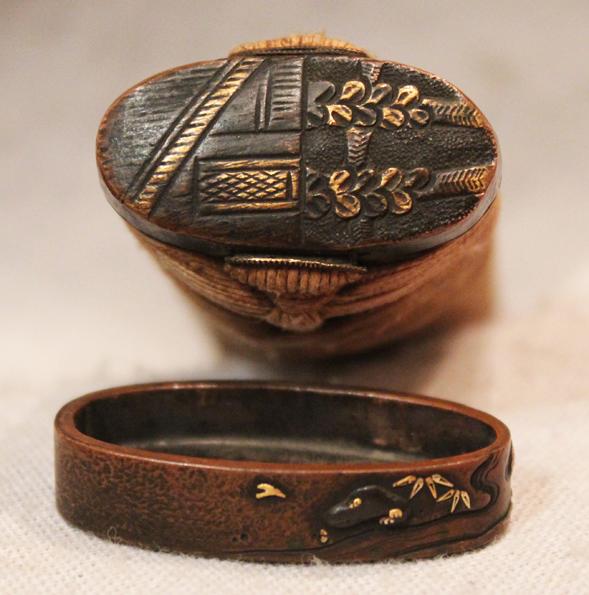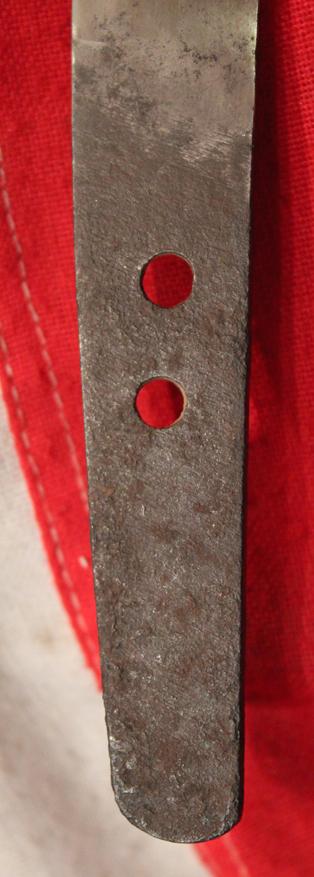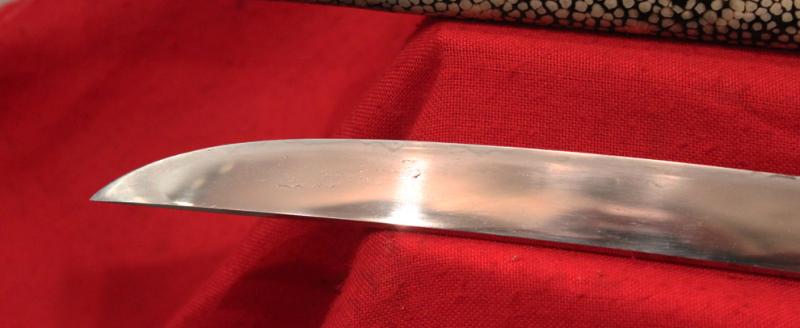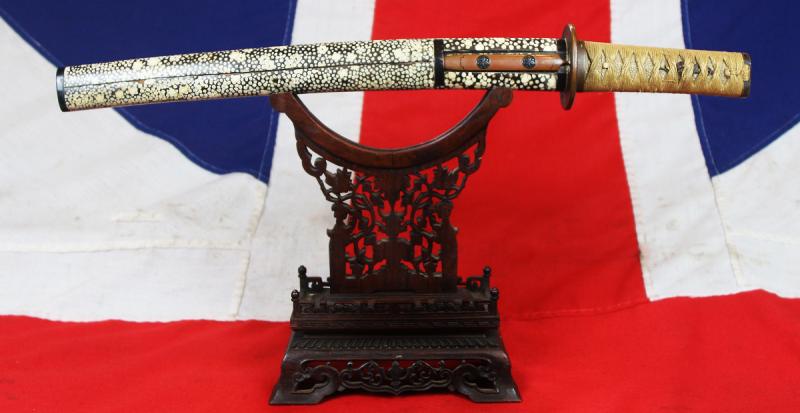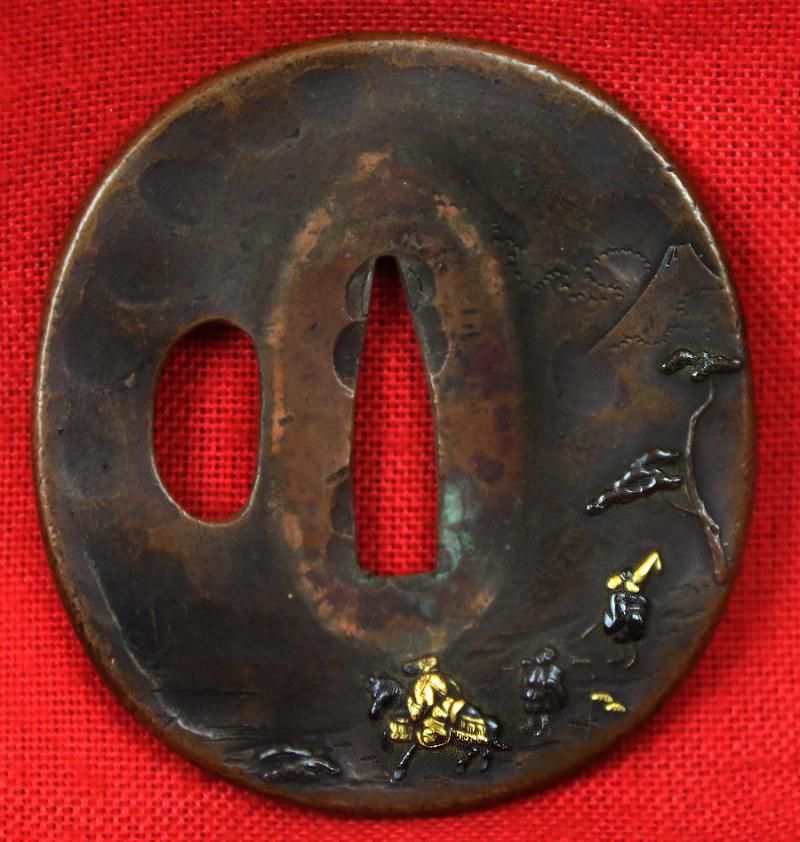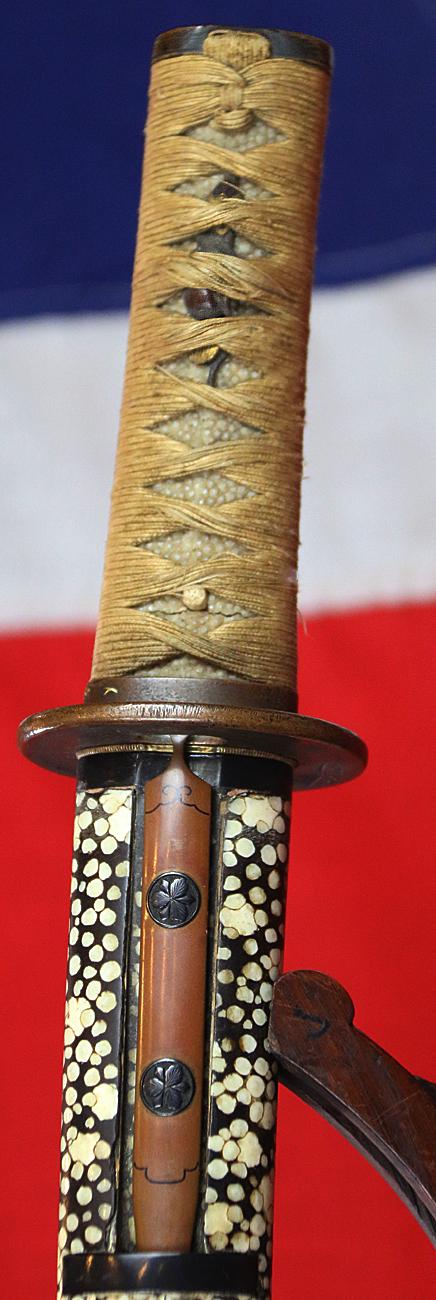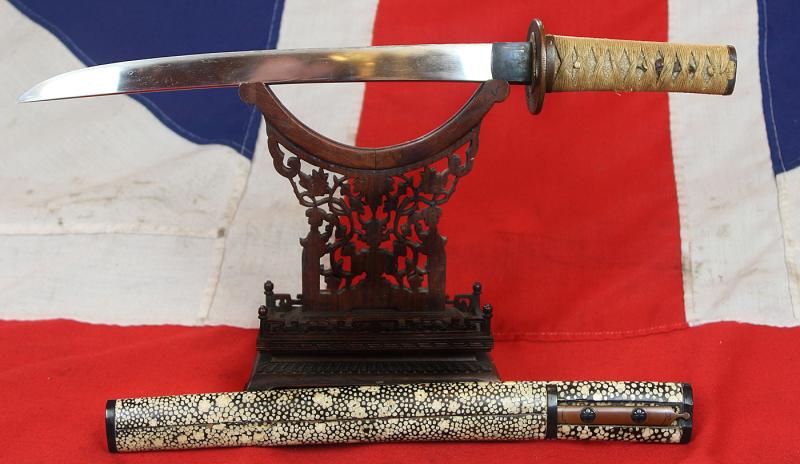.An Ancient Samurai Nambokochu Era Hira Zukuri Ancient Tanto Circa 1390. Stunning Polished Giant Rayskin {Kairagi-Gawa} Saya. Twin Clan Mon of Nakui Kagetaka of Triple Pawlonia Leaves Interspersed With Three Ken Swords.
This most ancient original short sword has a simply stunning and superb quality, original, Edo period, polished giant kairagi ray skin saya, "Kairagi" means "Ume Blossom Skin".When you polish the skin, Ume Blossom patterns will appear.
Kairagi-same is very rare. In simply fabulous condition, with a kogai pocket containing its highest grade and quality shakudo kogai, with a shakudo clan mon onlaid, of Nakui Kagetaka.
Kagetaka was born the eldest son of Nukui Tsugumune in Noto Province. Kagetaka's grandfather, Nukui Fusasada, had risen to be the most influential member of the Hatakeyama clan. In a bid to reclaim power, Fusasada was killed in 1555 by Hatakeyama Yoshitsuna. In response, the Nukui clan rose in an unsuccessful revolt, leading to Kagetaka fleeing to Kaga Province for safety. He remained in Kaga until 1566, when Yoshitsuna was subsequently cast out by other clan retainers, clearing the way for Kagetaka to return back to the Hatakeyama.
Within a few years, the much larger Oda and Uesugi clans began competing for control over the lands that Kagetaka called home. Chō Tsugutsura used this escalating conflict to attack Kagetaka and his allies, driving him into allaince with the Uesugi. Tsugutsura in turn called for aid from the Oda, but was isolated because the Oda were bogged down by their own inconvenient insurrection (Matsunaga Hisahide chose that moment to declare his own rebellion). By 1577, the main army of Uesugi Kenshin invaded Nanao Castle, with Kagetaka secretly aiding Kenshin by collaborating with Yusa Tsugumitsu to murder Chō Tsugutsura and the rest of the Chō clan.
While Nukui Kagetaka failed to kill Tsugutsura, he did manage to retake Nanao castle. Kagetaka maintianed this control until Kenshin died in 1578. With Kenshin gone, the Oda moved in and placed Nanao castle under seige. Kagetaka chose to abandon the castle to the Oda and Tsugursura, seeking shelyer with the Uesugi. In 1582, Kagetaka joined Uesugi Kagekatsu on campaign to retake Noto, but he was killed in battle against Sakuma Morimasa and Maeda Toshiie during the Arayama War.
The kogai or sword needle, was a samurai's hairdressing tool. The main parts of the kogai are the grip section called do (胴), the needle itself called sao (棹 or 竿) and the little scoop at the back of the grip called mimikaki (耳掻). The saya is polished samegawa, that is then termed Kairagi-Gawa that is transformed giant ray skin, as samegawa, was, at the time of the samurai, some one of the most expensive and highly prized forms of decoration, effectively super hardened marine leather, to be used on sword scabbards, saya. It was the same material as is used on sword hilts under the binding, but the large and small protruding nodules were hand polished, for hundreds of hours, to create a highly polished flat surface, that was then hand dyed and thus created a decorated scabbard with immense natural beauty, and created at huge expense for the time.
Very attractive tsuba of an oval copper plate with inlaid shakudo and gold takebori figures of a mounted samurai and retainers, beneath Mount Fuji at the horizon. Copper and gold onlaid fushigashira on a botanical theme. The blade is most ancient and beautiful looking. A samurai weapon perfect for one who is interested in ancient samurai history and the form of original weapons carried at that time. In the late fourteenth century, the Kantō region was dominated by powerful warrior families. Of these, the Uesugi were the most powerful. They were able to take advantage of the fighting that erupted between families in the region to advance their own interests. In 1368, the Utsunomiya family revolted against the Kamakura headquarters of the Muromachi regime, because they had lost their shugo posts to the Uesugi. The Uesugi family was able to extend their influence by amassing shugo military governor posts under their jurisdiction, and by enfoeffing vassals in the Kantō region at the expense of other families. One could advance a theory that the Kantō region had become semi-independent from Kyoto, and that the Kamakura headquarters of the Muromachi regime existed because of Uesugi support. The Uesugi family was legally recognized by the Muromachi regime by their appointment to the Kantō kanrei post because of their unassailable position. The blade’s hamon is very narrow indeed, typical for blades of such great age, and thus due to its great age, and its yakiba partially contacts with the edge.
As once told to us by an esteemed regular visitor to us here in our gallery, and the same words that are repeated in his book;
“In these textures lies an extraordinary and unique feature of the sword - the steel itself possesses an intrinsic beauty. The Japanese sword has been appreciated as an art object since its perfection some time during the tenth century AD. Fine swords have been more highly prized than lands or riches, those of superior quality being handed down from generation to generation. In fact, many well-documented swords, whose blades are signed by their makers, survive from nearly a thousand years ago. Recognizable features of the blades of hundreds of schools of sword-making have been punctiliously recorded, and the study of the sword is a guide to the flow of Japanese history.”
Victor Harris
Curator, Assistant Keeper and then Keeper (1998-2003) of the Department of Japanese Antiquities at the British Museum. He studied from 1968-71 under Sato Kenzan, Tokyo National Museum and Society for the Preservation of Japanese Swords
Overall 20 inches long in saya, blade inches 13.25 from tsuba to tip long
Code: 24451



